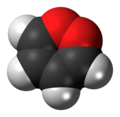 | |||
| |||
| Names | |||
|---|---|---|---|
| Preferred IUPAC name 1,2-Dioxine | |||
| Systematic IUPAC name 1,2-Dioxacyclohexa-3,5-diene | |||
| Identifiers | |||
3D model (JSmol) | |||
| ChemSpider | |||
PubChem CID | |||
| UNII | |||
CompTox Dashboard (EPA) | |||
| |||
| |||
| Properties | |||
| C4H4O2 | |||
| Molar mass | 84.074 g·mol−1 | ||
| Related compounds | |||
Related compounds | Dibenzodioxin | ||
Except where otherwise noted, data are given for materials in their standard state (at 25 °C [77 °F], 100 kPa). | |||
1,2-Dioxin is a heterocyclic, organic, antiaromatic [1] compound with the chemical formula C4H4O2. It is an isomeric form of 1,4-dioxin (or p-dioxin).

1,2-Dioxin (left) and 1,4-dioxin (right)
Due to its peroxide-like characteristics, 1,2-dioxin is very unstable and has not been isolated. Calculations suggest that it would isomerize rapidly into but-2-enedial. [2] Even substituted derivatives, such as 1,4-diphenyl-2,3-benzodioxin, are very labile. [3]

Structure of the transient 1,4-diphenyl-2,3-benzodioxin
In 1990, 3,6-bis(p-tolyl)-1,2-dioxin (1) was incorrectly reported as the first stable derivative. [4] It was subsequently shown that the initial compound was not a derivative of 1,2-dioxin, but a thermodynamically more stable dione (2). [5]

Dioxin (1) and dione form (2)




